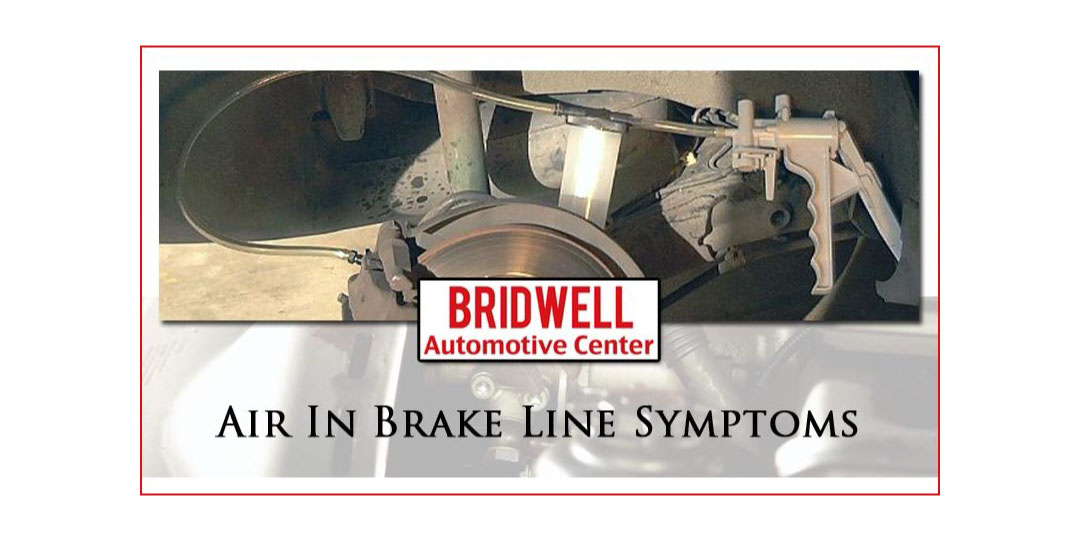Have your brakes felt soft or a little too spongy? If you’ve felt a softening of your brakes, there is a good chance you have air in the brake line. When you feel this in your car it’s critical to take the time to resolve it. While it could be air causing the soft feeling in the brakes it could be a master cylinder issue as well.
Air In Brake Line Symptoms
Power brakes, that are standard in most modern vehicles, rely on brake fluid to work. When you depress the brake pedal hydraulic force is transferred to the brake calipers. They in turn press the pads into the brake rotors to slow or stop the vehicle. Air is much less dense when compared to the brake fluid. This means if air is in the lines it will compress too easily. When this happens, your brakes will feel too soft or even spongy.
- Brakes Feel Spongy
- Brakes Feel Soft
- Brake Pedal Depressed Too Far
If you’ve felt any of these air in the brake line symptoms, don’t delay, get your brakes checked out by our professional team of brake repair technicians.
How Does Air Get In My Brake Lines?
While the brake system in modern vehicles is designed to be air tight, over time air does get in. This is due to your brake pads needing to move further as the pads wear down. Your brake calipers extend to maintain a uniform distance. To do this the hydraulic pistons also need to extend, causing a void in the hydraulic system. As your pads wear down more brake fluid is needed to supply your system.
Most people aren’t closely monitoring their brake fluid so as the system works harder to depress the brake pads, air is unfortunately drawn into the system. It is this air that causes your brakes to feel spongy or soft.
How To Bleed Brakes: Getting The Air Out
To return your vehicle’s braking system to like new condition will require removing the air. This is a job some car owners can do for themselves, but many prefer to leave their car’s safety in the hands of ASE Certified technicians.
Professional Brake Bleeding
In the hands of trained professional auto repair technicians your brake system will be completely voided of air in the system and brake lines. This ensures the function of your primary safety system, the ability to stop.
DIY Brake Bleeding
You’ll need a helper, safety glasses, wrenches, a jar to catch brake fluid, and a vinyl tube. Fi you’re doing all 4 brake lines you’ll need about 2 quarts of brake fluid.
Step 1. Fill brake fluid
Make sure that your brake fluid, found in your engine compartment, is fill up to a quarter inch below the maximum level.
Step 2. Find bleeder screws
To do this you’ll need to remove the tires. Unless you’ve got a lift you’ll likely need to jack each of the tires up individually and block the vehicle so it doesn’t roll. With the tire removed locate the brake syste bleeder screws. If you’re struggling to loosen a bleeder screw you may need to oil it.
Step 3. Hook Up Tube To Bleeder Screw
Next you’ll want to hook up your vinyl tube that leads to your jar to the bleeder screw. Start with the one furthers from the master cylinder. In a lot of vehicles this ends up being the back right tire.
Step 4. Apply The Brakes
This is where your helper comes in handy as someone needs to pump the brakes and then hold the brake pedal down. This needs to be done and held all the way through the next step.
Step 5. Bleed Off Fluid & Air
With your helper holding down the brake pedal as far as it will go loosen the bleeder screw and allow the brake fluid and air to escape. The brake pedal should go all the way to the floor during this process. Your helper needs to let you know when the pedal goes all the way down.
Step 6. Tighten Bleeder Screw
Before your helper removes the pressure from the brake pedal make sure you tighten your bleeder screws back down. If your helper removes their foot before this is done you’ll effectively add air to your brake lines.
Repeat this step until there’s no air bubbles!
Step 7. Replenish Fluid As You Work
Make sure you’re replenishing the brake fluid between your tires and keeping it a quarter inch below the maximum. Try to do your brakes starting with the back right, then left, followed by the right front then left front.
Step 8. Refill Master Cylinder
Ensure all your bleeder screws are tightened back down and then fill your master cylinder brake fluid reservoir to the right level. This process should, when done right, remove the air from your brake system. You’ll be back to having solid braking and confidence on the road.
Solo Brake Bleeding – For motorists that have the time they can purchase a vacuum pump kit to remove the air. Kits usually run about $35 dollars with tax and are good for DIY people who will use them often. They simply hook up to the bleeder screw and pull the air out with some pumping action.
Air In Brake Line After Bleeding
If you’ve tried these steps and still feel like you’ve got air in the brake line after bleeding, you should contact us for professional repair. We have the tools, training, and time to hunt down whatever is causing your brakes to feel unresponsive. Let our trained team of ASE Certified brake repair technicians help restore your safety and confidence in your vehicle.
How To Replace A Brake Line
Replacing a brake line is typically a job that requires specialized tools and is best handled on a lift at our shop. These are the steps we take to replace brake lines that are overly corroded, damaged, and cannot be repaired. For this job you’ll need a line wrench that’s meant for flared nut.
Step 1: Jack Up The Vehicle
You’ll need to have the wheel off and to do so you need to place a jack under the vehicle and raise it. In our shop we simply put it on a lift to have a rock solid platform to handle these types of repairs.
Step 2: Remove The Wheel
To give yourself better access to the brake line you will need to remove the wheel. Get your lug wrench and loosen your lug nuts. With the tire off it will be much easier to see any corrosion and remove the brake line or lines that aren’t safe.
Step 3. Spray Clips & Connections
Brake lines are dirty and exposed to all sorts of road conditions and might be seized. Start by using penetrating lubricant to spray rusted clips and where your brake line meets the drum or caliper. It takes time for this spray to work so you will want to give it 30 min to 1 hour.
Step 4. Remove Fittings With Line Wrench
The fittings hold the line against the drum and the caliper. Using your line wrench loosen all the fittings and be ready to cap off your brake lines. You will likely need a second wrench to loosen the fittings.
Step 5. Cap Brake Lines
With the brake line removed the system will ooze brake fluid. Brake fluid will ruin your paint and stain concrete. Cap off the lines as fast as possible and make sure to rinse your vehicle if any gets on the paint with cool water immediately.
Step 6. Clips & Fasteners
Along the body and struts your brake line is held on by fasteners and clips. You’ll need to remove them to get the brake line out before installing the new one. Use a wrench to remove all the fasteners and remove the brake line from the vehicle.
Step 7. New Brake Line Installation
Install the new brake line using your line wrench. If your vehicle calls for copper washers make sure to use them. It’s critical to use the line wrench when tightening the fittings as it’s made for the job. Otherwise you run the risk of ruining the bolts.
Step 8. Fill Brake Fluid, Bleed Air, & Test
It’s impossible not to lose a little brake fluid during a line replacement. Fill up your brake fluid and then bleed air from the lines. If you skip the bleeding air step you’ll have spongy brakes and a higher chance of early corrosion in the new brake line. Once that’s done you should test your brakes while parked in your driveway. Make sure they work properly before taking your car for a short test drive.
Schedule Brake Repair Services
If you live or work near Scottsdale Bridwell Automotive Center is your source for fast, affordable, and efficient brake and auto repairs. We hire repair technicians with the best training and certifications so you have confidence in all of our brake repairs. Please call to ask questions or schedule your brake repair appointment.[spacer height=”20px”]
Call (480) 948-4781 or Contact Us




